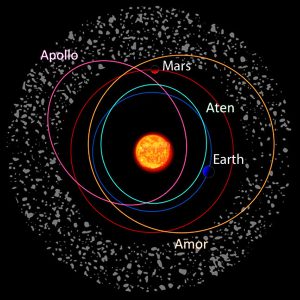
Near-Earth asteroids are in turn subdivided into 3 types: Apollo asteroids (those whose perihelion is closer than the Earth's orbit, and therefore cross its orbit), Love asteroids (located between Earth and Mars) and Aton asteroids. (whose orbit is normally within the Earth's orbit).
Aton: Asteroids with an orbit whose semimajor axis is smaller than that of the Earth (1 AU), although they can cross the Earth's orbit.
Apollo: Asteroids with an orbit whose semimajor axis is greater than that of the Earth (1 AU), and whose perihelion is less than the aphelion of the Earth.
Love: Asteroids whose orbit is between that of the Earth and Mars, crossing the Martian orbit but not the Earth's.
These families of asteroids make up the current NEA discoveries. An NEA, by definition, is an object whose trajectory brings it closer to the Earth at less than 1.3 ua* from the Sun and less than 0.3 ua* from the Earth.
ua: astronomical unit (in English ouch), used in astronomy to denote distances of objects within the Solar System. 1 ua is equivalent to the average distance between the Sun and the Earth (149,597,870,700 km).
A quasi-satellite It is an object that during its orbit around a star, is in 1:1 resonance with some planet, as seen in the animation. For a quasi-satellite of Earth, it would mean orbiting the Sun in the same 365 days as we do.
A quasi-satellite completes an orbit around the star in the same time as the planet, but with a different eccentricity. When viewed from the planet's perspective, the quasi-satellite appears to move in a retrograde, “oblong” orbit around the planet, hence the name “quasi-satellite.” An example of this type of object is 2014OL339, Earth's 4th known quasi-satellite (discovered by Farid Char, author of this website!).

